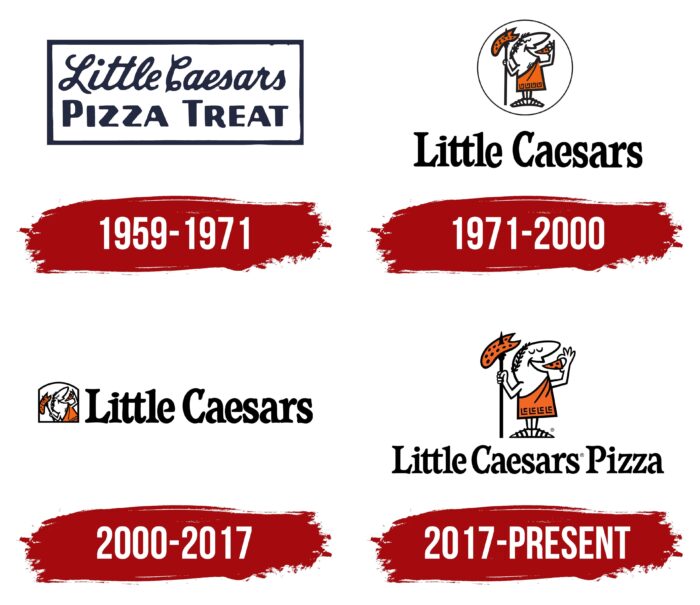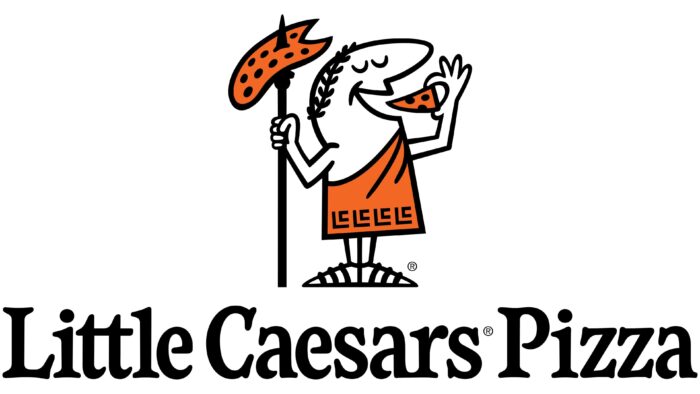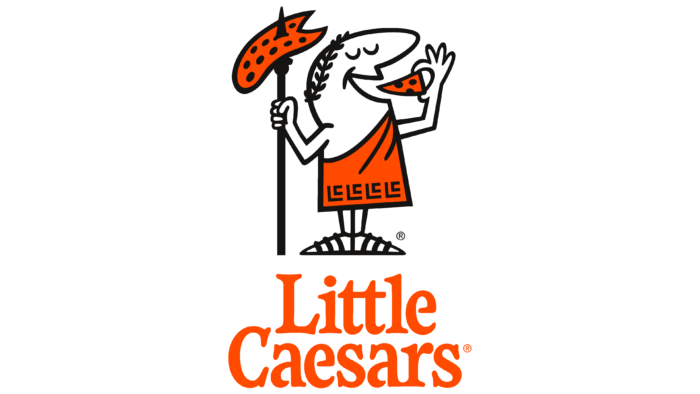The emblem contains a hint of the pizza’s origin. The company is trying to show that the network offers a dish prepared according to original Italian recipes. The Little Caesars logo also shows the longevity of the pizzeria.
Little Caesars: Brand Overview
Little Caesars is an acronym for Little Caesar Enterprises Inc., an American pizza chain owned by Ilitch Holdings. According to statistics obtained for 2020, it became the third-largest pizza chain in the United States, behind only such famous fast-food restaurants as Pizza Hut and Domino’s Pizza. The founders of the fast-food restaurants are Ilitch’s husband and wife, Mike and Marian. They run the firm, which has evolved into a franchise with independent branches in Latin America, the Caribbean, the Middle East, and Asia. The chain is also well-established in Canada, where it has many locations. The first pizzeria appeared in the spring of 1959 in Detroit, Michigan. Currently, its head office is concentrated there, located in the Fox Theater building.
In 1959, a visionary couple opened “Little Caesars Pizza Treat” in Garden City, Michigan. This small restaurant began what would grow into a global pizza empire. By 1962, they began franchising, fueling expansion across the U.S. and later worldwide.
A significant leap occurred in 1967 when Little Caesars introduced the groundbreaking “Pizza! Pizza!” concept, offering two pizzas for the price of one competitor’s. This innovative deal promoted a defining growth strategy, helping Little Caesars stand out in the bustling pizza market.
The brand saw explosive growth through the 1970s and 1980s, boasting over 4,000 locations worldwide by the end of the 1980s. The “Pizza! Pizza!” slogan, coined in 1979, became synonymous with the brand, embedding itself in the hearts of pizza lovers everywhere.
In 1989, Little Caesars introduced a signature pizza that became an instant favorite. It was made with mozzarella cheese, tomato sauce, and a special blend of spices. This addition highlighted the chain’s dedication to quality and flavor.
The 1990s featured an ambitious move: the acquisition of naming rights to the “Pontiac Silverdome,” which was rebranded as the “Little Caesars Pizzadome.” This decision reflected the brand’s growing influence.
The 2010s were marked by innovation, with the introduction of the “Deep! Deep! Dish Pizza” and the Bacon-Wrapped Crust.
In 2017, Little Caesars unveiled “Pizza Portals,” automated vending machines that made picking up pre-ordered pizzas a breeze. These machines emphasize convenience and service.
When the COVID-19 pandemic hit in 2020, Little Caesars quickly adapted by implementing contactless delivery options, ensuring the safety of both customers and staff.
Today, Little Caesars is the third-largest pizza chain in the U.S., celebrated for its affordable prices, inventive products, and memorable advertising. Despite stiff competition, the brand remains committed to providing high-quality pizza at reasonable prices.
Meaning and History
Mike Ilitch and his wife, Marian Ilitch, once opened a mini-pizzeria in suburban Detroit, setting it up in the Garden City Mall of Michigan. It was called Little Caesar’s Pizza Treat and became the basis for a large-scale food service chain. That store lasted an incredibly long, closing in the fall of 2018.
At first, the company caught visitors’ attention with an advertising slogan that included the word “pizza” twice. This was because the firm offered two combined pizzas for the price of one. This was her way of fighting off the competition. At first, the baked goods were served in a square corrugated cardboard box. Staples connected packages. However, the management switched to standard boxes because the previous ones were too bulky.
This brand is famous because, in the 1998th year, it fulfilled the largest order and baked for one customer 13,386 pizzas. The order came from Greensboro, North Carolina, from VF Corporation. She’s also known for being the first company to use an innovative conveyor belt oven to make pizzas fast. But in addition to it, the catering chain also served fish, shrimp, chicken, and hot dogs.
Since 2014, the company has been expanding its representative offices by building new facilities. Little Caesars Arena opened late and didn’t occur until 2017. In parallel, it redesigned the logo to present it at the center’s launch. The changes were mostly about details, not the concept of the logo. The developers made Caesar’s chest hairless, updated the wreath on his head, and changed the ornamentation on the toga so that the monogram “LC,” meaning “Little Caesars,” was visible in the pattern. In addition, the company used the updated image in advertising, replacing the cartoon character with it. In all, there are four logos in its history.
What is Little Caesars?
Little Caesars is the trade name of a pizza chain that is officially registered as Little Caesar Enterprises Inc. It has existed since 1959 and is a private enterprise of the American company Ilitch Holdings. The network is growing rapidly because it actively sells its franchises. Its restaurants are open in the US and abroad, including in Asia, so the famous Little Caesars logo is known to pizza connoisseurs worldwide.
1959 – 1971
The debut logo was not very creative. It consisted of a rectangular frame with the then name of the pizzeria, Little Caesars Pizza Treat, written on a white background. The long phrase took up two lines. The text at the top resembled handwriting and was slightly slanted to the right. It had many curls and rounded lines. The letters “tt” were connected by a single horizontal stroke, and the “L” stood alone and did not blend in with the other characters. The inscription in the lower part was typed in a printed font with a wide inter-letter space (compared to the first half of the name).
1971 – 2000
The catering establishment undertook a major rebranding after increasing the number of pizzerias and covering new service areas. It abandoned the old and long name and chose a shorter name, Little Caesars. The logo depicted exactly what the name said: Little Caesars.
The man was standing in a toga slung over his shoulder and holding a piece of pizza he was about to eat. The contented smile on his face indicated this: his mouth was open, and his eyes were closed as if the character was enjoying a delicious meal. He held a spear with a round pizza on the spike in his right hand, from which a triangular slice had been cut off.
The image was on a white background inside a thin ring. Beneath it was an inscription in stylized lower-case letters. Only the “L” and the “C” at the beginning of the word were capitalized. All signs had spike-shaped serifs that resonated with the tip of a spear. The vowels “a” and “e” had an original design: miniature spaces in the solid lines.
2000 – 2017
The changes that took place were mostly about color, dislocation, and scaling of elements. The designers moved the network’s name to the right and painted it orange with a black outline. They enlarged Caesar, using only a fragment from the previous image. The developers also tilted the person to the left (diagonally) and circled the frame as an order dispensing window, such as those in catering outlets.
2017 – today
Although the corrections are not conspicuous, they are fundamental and play an important role in the brand identity. For example, on the hem of the toga, the authors depicted an ornament in the acronym “LC,” which stands for the company name abbreviation. The letters are thin, not overlapping, and arranged inside the other. Another change is in the wreath: the wreath is much more noticeable due to the clear drawing of the leaves.
The artists removed the hair from the chest, moved the man’s eyes slightly to the right, and enlarged them, adding expressiveness to the image. In addition, the character now holds three fingers outstretched instead of two, which is more in keeping with reality. This gesture suggests the pleasure with which Caesar puts a dainty slice of pizza in his mouth, anticipating its great taste. The designers used old lettering, bringing back a version of 1971 and adding the word “Pizza.”
Little Caesars: Interesting Facts
Little Caesars Pizza, a well-known American pizza chain, is celebrated for its effective marketing, low prices, and unique pizza options.
- Beginning and Expansion: Founded by Mike and Marian Ilitch on May 8, 1959, in Garden City, Michigan, this single pizza shop has grown into a major global pizza chain.
- How It Got Its Name: The chain was originally called “Little Caesar’s Pizza Treat.” “Little Caesars” was Marian’s sweet nickname for Mike.
- “Pizza!Pizza!”: Known for offering two pizzas for the price of one, this deal became a cornerstone of their 1990s expansion.
- “Hot-N-Ready” Pizzas: Famous for its ready-to-go pepperoni pizza, this concept offers customers a quick and cheap meal option without waiting or ordering ahead.
- Crazy Bread: Besides pizza, Little Caesars is known for its “Crazy Bread,” garlicky breadsticks that became as popular as pizza since their introduction in the 1980s.
- Love Kitchen: A mobile pizza kitchen that serves free pizza to those in need across North America, showcasing the brand’s dedication to giving back to the community.
- Support for Veterans: Through the Little Caesars Veterans Program, qualified veterans receive incentives to open their own Little Caesars franchises, helping them transition to civilian life.
- Going Green: Little Caesars has made efforts to be more sustainable, such as introducing an energy-efficient pizza oven that reduces energy use.
- World Record Pizza: In 1997, the brand set a world record with a 250-foot diameter pizza, highlighting its fun-loving promotional style.
- Private Ownership and Diverse Interests: Little Caesars remains privately owned and continues to innovate under the Ilitch family, expanding into the sports and entertainment sectors.
Little Caesars’ commitment to affordability, convenience, and community service has solidified its position in the fast-food world. Its inventive approach continues to win over pizza lovers globally.
Font and Colors
Ten years after its opening, the management of the fast-food chain abandoned the unimpressive logo, which was used mainly as a signboard. They took the basic image from the name, depicting a miniature Caesar, famous for his ability to do everything all at once, a lot, and perfectly. It appeared in 1971 and was subsequently slightly tweaked.
The Little Caesar emblem features bold, elegant lettering in a custom serif font. This font is thick and smooth with slightly narrowed, rounded characters, giving the logo a unique and modern look. While similar to the Waverly RR ExtraBold Condensed and Sabre Medium fonts, it has been slightly tweaked to fit Little Caesar’s style better.
The logo uses a striking mix of orange, black, and white colors. Orange brings energy and vibrancy, black conveys strength and authority, and white adds a clean, professional touch. This combination makes the logo stand out and embodies the brand’s dynamic and confident nature.
FAQ
What is the Little Caesars’ slogan?
In 1979, Little Caesars introduced the slogan “Pizza! Pizza!” and it quickly gained popularity. This phrase was effective because it communicated that customers could receive two pizzas for the price of one, a unique offer at the time. This strategy distinguished Little Caesars, making it recognized for its exceptional value. The slogan conveyed the pleasure of affordably enjoying a meal together. As a result, Little Caesars became a popular choice for families seeking a budget-friendly pizza option. The “Pizza! Pizza!” slogan effectively made Little Caesars memorable as a source for delicious, economical pizzas, demonstrating the impact of a well-crafted slogan on brand recognition.
When did Little Caesars change their logo?
In 2017, Little Caesars updated their logo to coincide with the opening of their new arena, making a few subtle updates. They removed Caesar’s chest hair for a neater appearance and adjusted his wreath to look fresher. The most creative change was incorporating the letters “LC” into Caesar’s toga, blending traditional elements with a modern flair. These changes aimed to keep the brand’s image vibrant and appealing while maintaining its unique characteristics.
Why is it called Little Caesars?
Little Caesars began as a small business and has grown into a large pizza chain. The founders, Mike and Marian Ilitch, named it “Little Caesar’s Pizza Treat” in 1959. They wanted to offer something special beyond pizza. Marian nicknamed her husband “Little Caesar” because he was ambitious and a strong leader, reminiscent of the Roman leader Julius Caesar but kinder. They later renamed the business to “Little Caesars.” This change gave the brand a more personal touch and made it stand out. It suggested that Little Caesars was family-oriented, not merely a pizza shop. The story of its name highlights the importance of selecting a meaningful name.
Who was Little Cesar?
“Little Caesar” is a 1931 movie about Rico, a small-time criminal with big ambitions. Directed by Mervyn LeRoy, the film has influenced the cinema’s portrayal of gangsters. Edward G. Robinson’s portrayal of Rico became iconic thanks to his tough demeanor and expressive acting. The character of Rico is thought to draw inspiration from Al Capone, a real crime boss, due to the similarities in their rise and downfall. “Little Caesar” and its main character, Rico, are significant in film history for depicting the lifecycle of a gangster, incorporating elements reminiscent of figures like Capone.
What is the meaning of the Little Caesars Logo?
The Little Caesars logo is smart and engaging. It features a cartoon Roman man wearing a toga, which reflects the company’s name, Caesar. This design cleverly combines elements of ancient Roman style with the modern-day enjoyment of pizza. The character is depicted enjoying a slice of pizza, perfectly capturing Little Caesars’ essence. This blend of historical and contemporary elements makes the logo memorable and distinctive.
Including a Roman figure in the logo draws a connection to the historical Caesar, lending a sense of history and credibility to the brand. However, the character is shown holding a pizza instead of a weapon, injecting a sense of humor and making the brand approachable. An ingenious aspect of the logo is the subtle incorporation of the letters’ LC’ into the toga’s pattern, cleverly integrating the brand’s initials into the Roman attire. The Little Caesars logo narrates a story of uniting tradition with the contemporary pleasure of enjoying pizza.
What does the logo symbolize, Little Caesars Logo?
The Little Caesars logo, with its fun Roman character, does more than look good. It pays homage to pizza’s rich origins in Italian culture and the Roman Empire. By showcasing a Roman figure, the logo ties pizza back to its ancient roots in Italy and its importance during the Roman Empire era. Using “Caesar” in the character’s name highlights the brand’s commitment to quality and a nod to history. The image of the Roman figure holding a slice of pizza makes the brand seem welcoming and friendly, suggesting that Little Caesars is a place where everyone can enjoy the happiness of sharing a pizza. Overall, the logo is a meaningful representation that celebrates pizza’s history and the happiness it brings today.
What is Little Caesar’s mascot?
The Little Caesar logo for Little Caesar Enterprises Inc. is a big part of what the pizza chain is all about fun, history, and delicious pizza. Here’s why Little Caesar is so appealing.
Little Caesar is easily recognizable with his bald head, big nose, and friendly smile. His outfit is an orange toga with black designs, similar to what Julius Caesar might have worn, linking the mascot to ancient Rome while keeping things lively with a bright color that grabs your attention. Little Caesar also wears black sandals, further connecting him to Roman history. He has a laurel wreath on his head, symbolizing victory and suggesting that choosing Little Caesars pizza is smart. Instead of a weapon, Little Caesar holds a spear with a pizza on it and a pizza slice in his other hand. This replaces a traditional symbol of power with one of happiness and delicious pizza, showing Little Caesars’ fun and imaginative side. Little Caesar is more than a logo; he’s a character that connects ancient Rome to the joy of eating pizza today.
Is Little Caesars mascot Julius Caesar?
The Little Caesars pizza mascot is inspired by ancient Rome, even though it’s not meant to be Julius Caesar himself. This character is dressed in a toga, sports a leaf crown, and carries a pizza, all to give off a vibe of Roman leadership but with a twist of fun. Using the name “Caesar” and giving the mascot a Roman-themed look helps evoke feelings of old Rome. The mascot is designed to be a cartoonish figure that blends elements of Roman style with the joy of modern pizza culture. It aims to evoke thoughts of victory and celebration, similar to those in Roman times, yet does so in a friendly and appealing way to pizza lovers.
Who designed the Little Caesars logo?
The Little Caesars Pizza Guy logo was created unexpectedly. In 1959, the same year the first pizza shop was opened, a friend named Don Silverstein sketched the original design on a napkin. This sketch, far from being just a casual drawing, became the basis for the iconic logo we recognize today. Don might not have been well-known as an artist, but his connection to the founders, Marian and Mike Ilitch, and his simple drawing had a significant impact. This initial doodle eventually evolved into the official logo, featuring the pizza man with a spear. It’s a playful icon that reflects the brand’s name and essence, incorporating Roman elements with pizza. This story illustrates how a brand’s most iconic symbol can originate from a spontaneous moment shared between friends.
What is the Little Caesars mascot name?
The Little Caesars mascot, “Little Caesar,” fits perfectly with the pizza chain’s theme. This character helps make the brand easily recognizable. The name “Little Caesar” strengthens the connection to the brand, making it more memorable. It’s a fitting choice since the mascot is small but full of character, offering a playful take on history. This mascot is central to Little Caesars’ brand, symbolizing its focus on enjoyable, affordable pizza. It helps the chain differentiate itself in a competitive market, making Little Caesars known worldwide.










